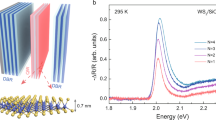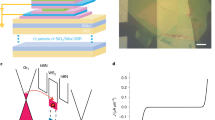Abstract
Exciton–polaritons derived from the strong light–matter interaction of an optical bound state in the continuum with an excitonic resonance can inherit an ultralong radiative lifetime and significant nonlinearities, but their realization in two-dimensional semiconductors remains challenging at room temperature. Here we show strong light–matter interaction enhancement and large exciton–polariton nonlinearities at room temperature by coupling monolayer tungsten disulfide excitons to a topologically protected bound state in the continuum moulded by a one-dimensional photonic crystal, and optimizing for the electric-field strength at the monolayer position through Bloch surface wave confinement. By a structured optimization approach, the coupling with the active material is maximized here in a fully open architecture, allowing to achieve a 100 meV photonic bandgap with the bound state in the continuum in a local energy minimum and a Rabi splitting of 70 meV, which results in very high cooperativity. Our architecture paves the way to a class of polariton devices based on topologically protected and highly interacting bound states in the continuum.
This is a preview of subscription content, access via your institution
Access options
Access Nature and 54 other Nature Portfolio journals
Get Nature+, our best-value online-access subscription
$29.99 / 30 days
cancel any time
Subscribe to this journal
Receive 12 print issues and online access
$259.00 per year
only $21.58 per issue
Buy this article
- Purchase on Springer Link
- Instant access to full article PDF
Prices may be subject to local taxes which are calculated during checkout




Similar content being viewed by others
Data availability
The data that support the findings of this study are available from the corresponding authors upon reasonable request.
Code availability
The codes used in this work are available from the corresponding authors upon request.
References
von Neumann J. & Wigner, E. P. Über merkwürdige diskrete Eigenwerte. in The Collected Works of Eugene Paul Wigner Vol. A/1 (Springer, 1993).
Zhen, B., Hsu, C. W., Lu, L., Stone, A. D. & Soljačić, M. Topological nature of optical bound states in the continuum. Phys. Rev. Lett. 113, 257401 (2014).
Jin, J. et al. Topologically enabled ultrahigh-Q guided resonances robust to out-of-plane scattering. Nature 574, 501–504 (2019).
Xiao, Y. X., Ma, G., Zhang, Z. Q. & Chan, C. T. Topological subspace-induced bound state in the continuum. Phys. Rev. Lett. 118, 166803 (2017).
Haq, O. & Shabanov, S. Bound states in the continuum in elasticity. Wave Motion 103, 102718 (2021).
Deriy, I., Toftul, I., Petrov, M. & Bogdanov, A. Bound states in the continuum in compact acoustic resonators. Phys. Rev. Lett. 128, 084301 (2022).
Capasso, F. et al. Observation of an electronic bound state above a potential well. Nature 358, 565–567 (1992).
Dai, S., Hu, P. & Han, D. Near-field analysis of bound states in the continuum in photonic crystal slabs. Opt. Express 28, 16288–16297 (2020).
Bezus, E. A., Bykov, D. A. & Doskolovich, L. L. Bound states in the continuum and high-Q resonances supported by a dielectric ridge on a slab waveguide. Photon. Res. 6, 1084–1093 (2018).
Muhammad, N., Chen, Y., Qiu, C.-W. & Wang, G. P. Optical bound states in continuum in MoS2-based metasurface for directional light emission. Nano Lett. 21, 967–972 (2021).
Joseph, S., Pandey, S., Sarkar, S. & Joseph, J. Bound states in the continuum in resonant nanostructures: an overview of engineered materials for tailored applications. Nanophotonics 10, 4175–4207 (2021).
Dang, N. H. M. et al. Realization of polaritonic topological charge at room temperature using polariton bound states in the continuum from perovskite metasurface. Adv. Opt. Mater. 10, 2102386 (2022).
Koshelev, K. L., Sychev, S. K., Sadrieva, Z. F., Bogdanov, A. A. & Iorsh, I. V. Strong coupling between excitons in transition metal dichalcogenides and optical bound states in the continuum. Phys. Rev. B 98, 161113(R) (2018).
Lu, L. et al. Engineering a light–matter strong coupling regime in perovskite-based plasmonic metasurface: quasi-bound state in the continuum and exceptional points. Photon. Res. 8, A91–A100 (2020).
Kavokin, A., Baumberg, J., Malpuech, G. & Laussy, F. Microcavities (Oxford Univ. Press, 2008).
Kodigala, A. et al. Lasing action from photonic bound states in continuum. Nature 541, 196–199 (2017).
Sanvitto, D. & Kéna-Cohen, S. The road towards polaritonic devices. Nat. Mater. 17, 1061–1073 (2016).
Ardizzone, V. et al. Polariton Bose–Einstein condensate from a bound state in the continuum. Nature 605, 447–454 (2022).
Zhao, J. et al. Ultralow threshold polariton condensate in a monolayer semiconductor microcavity at room temperature. Nano Lett. 21, 3331–3339 (2021).
Anton-Solanas, C. et al. Bosonic condensation of exciton–polaritons in an atomically thin crystal. Nat. Mater. 20, 1233–1239 (2021).
Manzeli, S., Ovchinnikov, D., Pasquier, D., Yazyev, O. V. & Kis, A. 2D transition metal dichalcogenides. Nat. Rev. Mater. 2, 17033 (2017).
Kravtsov, V. et al. Nonlinear polaritons in a monolayer semiconductor coupled to optical bound states in the continuum. Light. Sci. Appl. 9, 56 (2020).
Meade, R. D., Brommer, K. D., Rappe, A. M. & Joannopoulos, J. D. Electromagnetic Bloch waves at the surface of a photonic crystal. Phys. Rev. B 44, 10961–10964 (1991).
Lerario, G. et al. Room temperature Bloch surface wave polaritons. Opt. Lett. 39, 2068–2071 (2014).
Barachati, F. et al. Interacting polariton fluids in a monolayer of tungsten disulfide. Nat. Nanotechnol. 13, 906–909 (2018).
Bezus, E. A., Bykov, D. A. & Doskolovich, L. L. Integrated diffraction gratings on the Bloch surface wave platform supporting bound states in the continuum. Nanophotonics 10, 4331–4340 (2021).
Weber, T. et al. Strong light-matter interaction with self-hybridized bound states in the continuum in monolithic van der Waals metasurfaces. Preprint at https://arxiv.org/abs/2209.01944 (2022).
Ardizzone, V. et al. Emerging 2D materials for room-temperature polaritonics. Nanophotonics 8, 1547–1558 (2019).
Xenogiannopoulou, E. et al. High-quality, large-area MoSe2 and MoSe2/Bi2Se3 heterostructures on AlN/Si substrates by molecular beam epitaxy. Nanoscale 7, 7896–7905 (2015).
Lackner, L. et al. Tunable exciton-polaritons emerging from WS2 monolayer excitons in a photonic lattice at room temperature. Nat. Commun. 12, 4933 (2021).
Shan, H. et al. Spatial coherence of room-temperature monolayer WSe2 exciton-polaritons in a trap. Nat. Commun. 12, 6406 (2021).
Rosser, D. et al. Dispersive coupling between MoSe2 and an integrated zero-dimensional nanocavity. Opt. Mater. Express 12, 59–72 (2022).
Wang, S. et al. Coherent coupling of WS2 monolayers with metallic photonic nanostructures at room temperature. Nano Lett. 16, 4368–4374 (2016).
Lundt, N. et al. Observation of macroscopic valley-polarized monolayer exciton-polaritons at room temperature. Phys. Rev. B 96, 241403 (2017).
Qin, J. et al. Revealing strong plasmon-exciton coupling between nanogap resonators and two-dimensional semiconductors at ambient conditions. Phys. Rev. Lett. 124, 063902 (2020).
Rodriguez, S. R.-K. Classical and quantum distinctions between weak and strong coupling. Eur. J. Phys. 37, 025802 (2016).
Ballarini, D. et al. All-optical polariton transistor. Nat. Commun. 4, 1778 (2013).
Zasedatelev, A. et al. A room-temperature organic polariton transistor. Nat. Commun. 13, 378–383 (2019).
Ciuti, C., Schwendimann, P. & Quattropani, A. Theory of polariton parametric interactions in semiconductor microcavities. Semicond. Sci. Technol. 18, S279 (2003).
Ghosh, S. et al. Microcavity exciton polaritons at room temperature. Photon. Insights 1, R04 (2022).
Gu, J. et al. Enhanced nonlinear interaction of polaritons via excitonic Rydberg states in monolayer WSe2. Nat. Commun. 12, 2269 (2021).
Suárez-Forero, D. G. et al. Enhancement of parametric effects in polariton waveguides induced by dipolar interactions. Phys. Rev. Lett. 126, 137401 (2021).
Coriolano, A. et al. Rydberg polaritons in ReS2 crystals. Sci. Adv. 8, eadd8857 (2022).
Yoo, H., Heo, K., Ansari, M. H. R. & Cho, S. Recent advances in electrical doping of 2D semiconductor materials: methods, analyses and applications. Nanomaterials 11, 832 (2021).
Castellanos-Gomez, A. et al. Deterministic transfer of two-dimensional materials by all-dry viscoelastic stamping. 2D Mater. 1, 011002 (2014).
Taflove, A. & Hagness, S. C. Computational Electrodynamics: The Finite-Difference Time-Domain Method 3rd edn (Artech House, 2005).
Lindfield, G. & Penny, J. in Introduction to Nature-Inspired Optimization Ch. 3 (Academic Press, 2017).
Xu, G. & Yu, G. On convergence analysis of particle swarm optimization algorithm. J. Comput. Appl. Math. 333, 65–73 (2018).
Liu, V. & Fan, S. S4: a free electromagnetic solver for layered periodic structures. Comput. Phys. Commun. 183, 2233–2244 (2012).
Acknowledgements
We are grateful to C. Anton-Solanas for the fruitful discussions and for the help in the optimization of the fabrication process. We gratefully thank P. Cazzato for technical support, L. Dominici for fruitful discussions on the design solutions and L. Carbone for precious support in the development of the fabrication process. We acknowledge the CINECA award under the ISCRA C initiative (D.G. and E.M.) for the availability of high-performance computing resources and support. This work was supported by the Italian Ministry of University (MIUR) for funding through the PRIN project ‘Interacting photons in polariton circuits’—INPhoPOL (grant 2017P9FJBS) (D.S. and D.G.); the project ‘Hardware implementation of a polariton neural network for neuromorphic computing’—Joint Bilateral Agreement CNR-RFBR (Russian Foundation for Basic Research)—Triennal Program 2021–2023 (D.S.); the MIUR project ‘ECOTEC—eco-sustainable and intelligent fibers and fabrics for technic clothing’, PON R&I 2014-2020, project no. ARS0100951, CUP B66C18000300005 (V.M.); the Italian Ministry of Research (MUR) under the complementary actions to the NRRP (PNC0000007) ‘Fit4MedRob—Fit for Medical Robotics’ (grant-contract number CUP B53C22006960001) (V.M.); the MAECI project ‘Novel photonic platform for neuromorphic computing’, Joint Bilateral Project Italia–Polonia, 2022–2023 (D.S.); the PNRR MUR project ‘National Quantum Science and Technology Institute’ (NQSTI) (D.S. and D.G.); the PNRR MUR project: European Union—NextGeneration EU, ‘Integrated infrastructure initiative in photonic and quantum sciences’—I-PHOQS IR0000016, ID D2B8D520, CUP B53C22001750006 (D.S.); and the project ‘TECNOMED—Tecnopolo di Nanotecnologia e Fotonica per la Medicina di Precisione’ (MIUR Decreto Direttoriale no. 3449 del 4/12/2017, CUP B83B17000010001) (G.G.).
Author information
Authors and Affiliations
Contributions
E.M., L.P., F.T. and A.D.R. realized the samples. E.M. and D.B. conceived the idea. E.M. developed the nanofabrication process, numerical tools and theory/data analysis. L.P. performed the optical measurements. E.M., L.P., D.B., D.G. and D.S. wrote the text. A.C., M.P. and V.M. grew the dielectric mirrors. B.H. and C.S. contributed the exfoliated TMDs and mirrors for preliminary fabrication tests. L.D.M., R.M. and A.R contributed to the preparation of the samples. D.B., D.S. and D.G. supervised the project. All authors contributed to the discussion of the results and the text.
Corresponding authors
Ethics declarations
Competing interests
The authors declare no competing interests.
Peer review
Peer review information
Nature Materials thanks Andrey Bogdanov and the other, anonymous, reviewer(s) for their contribution to the peer review of this work.
Additional information
Publisher’s note Springer Nature remains neutral with regard to jurisdictional claims in published maps and institutional affiliations.
Supplementary information
Rights and permissions
Springer Nature or its licensor (e.g. a society or other partner) holds exclusive rights to this article under a publishing agreement with the author(s) or other rightsholder(s); author self-archiving of the accepted manuscript version of this article is solely governed by the terms of such publishing agreement and applicable law.
About this article
Cite this article
Maggiolini, E., Polimeno, L., Todisco, F. et al. Strongly enhanced light–matter coupling of monolayer WS2 from a bound state in the continuum. Nat. Mater. 22, 964–969 (2023). https://doi.org/10.1038/s41563-023-01562-9
Received:
Accepted:
Published:
Issue Date:
DOI: https://doi.org/10.1038/s41563-023-01562-9
This article is cited by
-
Applications of bound states in the continuum in photonics
Nature Reviews Physics (2023)
-
Manipulating the nonlinearity of transition-metal dichalcogenide polaritons
Light: Science & Applications (2023)
-
Enhanced sum-frequency generation from etchless lithium niobate empowered by dual quasi-bound states in the continuum
Science China Physics, Mechanics & Astronomy (2023)



